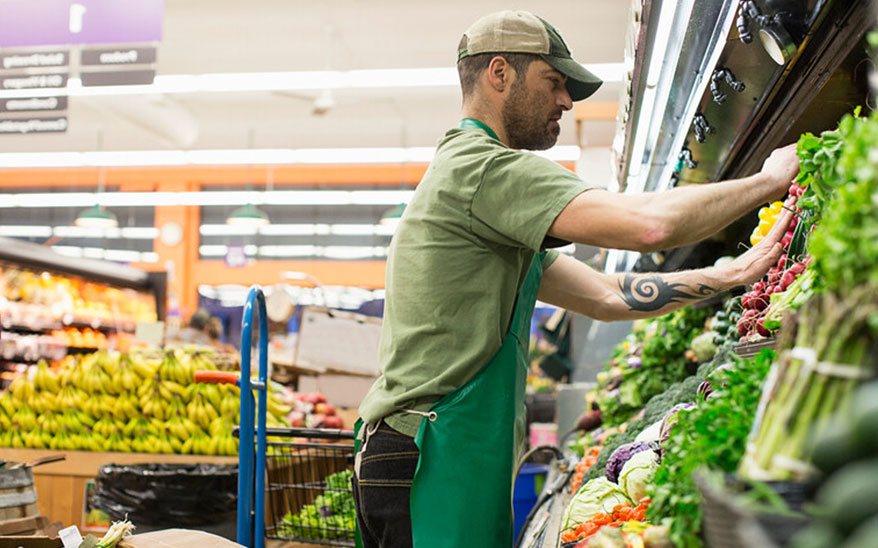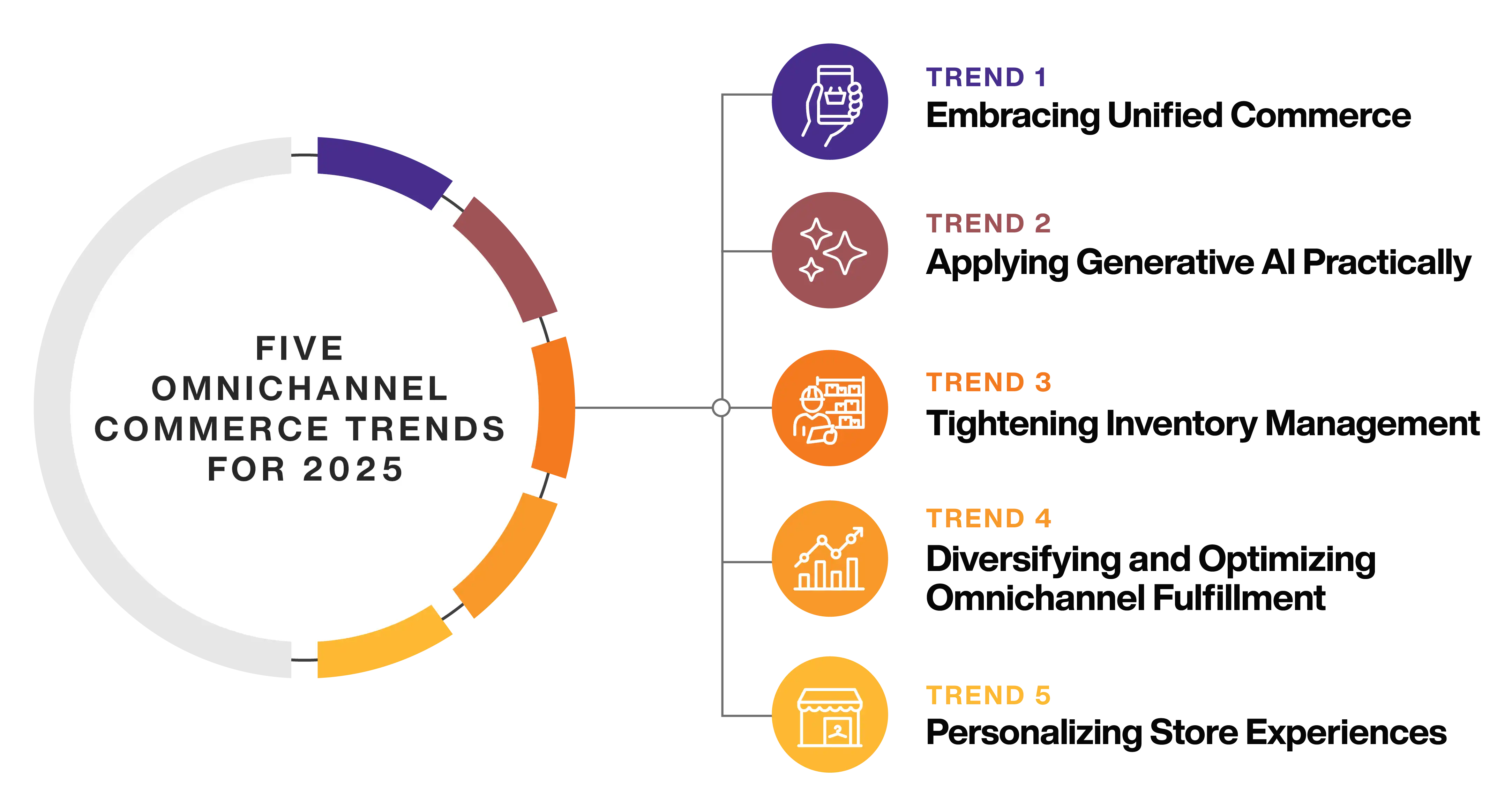
Omnichannel Commerce Retail Trends for 2025
Realizing the Flexibility to Balance Customer Value and Operational Costs
Omnichannel Commerce Retail Trends for 2025
Emerging Retail Trends in Omnichannel Commerce
2025 is poised to be a defining one for modern retailers, bringing both challenges and opportunities. February marked a significant downturn in US consumer confidence, with the index plummeting seven points—the most significant decline since August 2021. While the US economy deals with these issues, consumer confidence outside the US remains stable, offering a buffer for global retailers. In an environment where inflation and political uncertainty are diminishing consumer spending, retailer leaders must act decisively to grow while minimizing operational costs to protect their profits.
Simply slashing operational costs will not suffice. Today's consumers are discerning; they demand enhanced value from their shopping experiences. As they face mounting cost-of-living pressures, price sensitivity is at an all-time high. However, price alone will not drive sales. Consumers actively seek value-added experiences in their shopping journeys, such as greater delivery convenience, and they will reward those who deliver.
The complexities of the modern retail surface when considering the different consumer behaviors across generations. Take Generation Z (Gen Z) and Baby Boomers as prime examples. Gen Z, born between 1997 and 2012, accounts for approximately 25% of the global population and is projected to have an astounding spending power of $12 trillion by 2030. Baby Boomers, born between 1946 and 1964, control an impressive 51% of the wealth in the United States and outspend all other generations combined by $400 billion each year. Both generations are crucial to retailer success, yet their shopping habits and brand interactions diverge sharply.
The role of artificial intelligence (AI) exemplifies this generational divide. Research shows that 60% of Gen Z actively engage with tools like ChatGPT, integrating AI technology seamlessly into their daily lives. In contrast, while many Baby Boomers are unfamiliar with AI, but they are open to it if it enhances their convenience. This contrast underscores the necessity for retailers to adopt flexible AI strategies. Savvy retailers will recognize that engaging with Gen Z might benefit from advanced AI solutions, like generative AI-powered customer service chatbots. At the same time, Baby Boomers may prefer traditional customer service avenues like call centers. Those retailers that flexibly cater to both demographics stand to add remarkable customer value while reducing operational costs, such as reducing call center volumes through the use of Gen AI customer assistants.
Flexibility in commerce strategies and operations might be the ultimate, yet somewhat simplistic, answer to what modern retailers need to grow in 2025 and beyond. Flexibility that allows retailers to execute sales, inventory management, fulfillment, and service strategies tailored to how the different generations of modern shoppers want to interact, increasing their attractiveness to consumers. And flexibility that allows retailers to fine tune their commerce operations for cost savings that protect margins in a challenging consumer market.
Looking forward, five critical omnichannel commerce trends will advance in 2025 and beyond, setting the stage for retailers to excel. These trends will be pivotal for those modern retailers seeking to instill flexibility within their commerce organizations and processes—balancing customer value creation with stringent cost controls as they navigate the dynamic landscape ahead.
Five Omnichannel Commerce Trends for 2025
Trend 1: Embracing Unified Commerce
In today's retail landscape, most modern retailers have successfully achieved omnichannel commerce, delivering a seamless and consistent experience across all sales and service channels. Omnichannel commerce empowers customers to engage with their favorite brands anytime and anywhere. However, the future lies in unified commerce—the next evolution where retailers leverage a single, integrated platform that unifies sales, fulfillment, and service processes throughout the complete digital and physical shopping journey. By consolidating data and operations across multiple touchpoints, retailers can gain unparalleled control and improved execution, transforming market challenges into sustainable competitive advantages.
Modern shoppers expect consistent omnichannel execution across channels that unified commerce promises. However, research shows that retailers are falling behind in meeting these expectations. Research commissioned by Manhattan Associates found that only 17% of surveyed modern retailers rate their unified commerce capabilities as mature. However, a greater focus on maturing unified commerce capabilities is on the horizon, making unified commerce adoption a key omnichannel commerce trend for 2025. Manhattan's research survey of 256 specialty retailers in the US found that 38% of retailers are in the process of advancing their unified commerce initiatives in 2025.
The rewards of embracing unified commerce are substantial. Retailers that achieve a high level of maturity in their unified commerce approach report 27% lower fulfillment costs and 18% reduced cart abandonment rates, leading to significantly higher sales conversion rates. By adopting a unified commerce approach by 2025, retailers position themselves not only for growth but also for cost savings, ensuring they are well-equipped to thrive in an ever-evolving marketplace.
Trend 2: Applying Generative AI Practically
In 2025, generative artificial intelligence (Gen AI) is emerging as a transformative force across many industries, capturing headlines in technology worldwide. In the retail sector, predictions abound regarding Gen AI's potential to revolutionize operations by significantly enhancing both customer experiences and business efficiency. Among the most common applications are Gen AI-powered shopping assistants, which deliver personalized product recommendations through digital sales channels. Forrester forecasts that one in five retailers in the US and EMEA will introduce customer-facing generative AI applications this year.
However, the road to successful implementation is fraught with challenges. Gartner warns that as many as 30% of Gen AI initiatives could falter in 2025 due to inadequate data quality, escalating costs, and ambiguous business value. As such, this year is poised to be a critical proving ground for retailers venturing into Gen AI. Those who thrive will adopt practical strategies that deliver immediate consumer value, supported by robust commerce infrastructure that provides high-quality and timely data to power their Gen AI solutions.
One area where the application of Gen AI holds immense potential is retail customer service. The post-purchase experience is a pivotal factor in driving sales growth; retailers experiencing a 25% or greater year-over-year revenue increase prioritize this aspect far more than their slower-growing counterparts. By integrating a Gen AI customer assistant—such as a sophisticated chatbot—into an array of customer service channels, including call centers, physical stores, and digital self-service platforms, modern retailers can offer customers seamless and diverse options for managing their orders and returns, creating substantial added value.
Well-trained Gen AI customer assistants possess the ability to accurately understand and address customer inquiries supported by human-like sentiment. This level of effectiveness can mitigate up to 30% of calls to retail call centers, providing retailers with significant cost savings while simultaneously enhancing the overall customer experience. Embracing this innovative technology isn't just a strategic choice; it's a necessity for retailers seeking to cost-effectively lead in modern retail.
Trend 3: Tightening Inventory Management
In recent years, retailers have made significant strides in inventory control, restoring inventory-to-sales ratios to pre-pandemic levels of around 1 to 1.3. As we look ahead to 2025 and beyond, while inventory levels are increasing, retailers are more determined than ever to maintain greater control over their inventory levels to safeguard financial performance. Given that inventory represents the largest area of investment in working capital for most retailers, effective management is not just important—it's essential.
In 2025, modern retailers will intensify their focus on inventory control, honing their strategies and capabilities to master inventory management. A pivotal area of investment will be AI-powered supply chain planning tools. These advanced tools empower retailers to optimize stock levels and meet customer demands with unparalleled precision. By enhancing sales demand forecasting and automating replenishment processes, retailers can significantly reduce stock levels while decreasing the likelihood of out-of-stock situations. Furthermore, inventory allocation optimization tools can cut out-of-stock items by half and drive revenue increases of up to 5%.
Additionally, endless-aisle ordering—an innovative capability that allows any sales channel to place orders against inventory from any fulfillment point—will be a focal point in 2025. As retailers tighten their inventory, crafting strategies to prevent lost sales due to out-of-stock situations becomes paramount, especially in brick-and-mortar stores. Retailers will aggressively pursue 100% global inventory visibility across all fulfillment points, including distribution centers, stores, and suppliers, while streamlining order orchestration, such as facilitating seamless store-to-store orders.
By prioritizing these strategies, retailers will position themselves for success in a challenging environment, ensuring they not only meet customer expectations but also drive sustainable growth.
Trend 4: Diversifying and Optimizing Omnichannel Fulfillment
Modern retailers recognize that a comprehensive array of fulfillment options and timely order delivery are not just advantages—they are critical drivers of sales conversions. A survey of retail and e-commerce managers revealed that 44% of consumers abandon their carts due to uncertainty surrounding delivery options before checkout. A key omnichannel commerce trend for 2025 will be a greater focus by retailers on diversifying and optimizing fulfillment methods to provide flexible and rapid delivery solutions that attract new customers and foster loyalty among existing ones. However, this emphasis will have a critical strategic twist: a heightened commitment to controlling fulfillment costs.
Retailers today grapple with numerous challenges in managing these costs. Shipping fees have surged dramatically, with shipping carriers like FedEx and UPS hiking their prices by 33% since 2021 and implementing surcharges during peak seasons. On top of this, fulfilling orders from stores can be significantly more expensive—up to two times higher—compared to distribution center fulfillment.
To thrive in this environment, retailers must innovate and optimize their fulfillment strategies, aiming to deliver exceptional customer value while securing more profitable transactions. Research from Deloitte indicates that an increasing number of retailers will expand their in-house delivery capabilities by 2025, effectively reducing shipping fees. This shift will also encourage the establishment of micro-fulfillment centers over the next five years, enabling even more flexible and efficient delivery operations. Furthermore, retailers may begin experimenting with order surcharges for expedited deliveries to offset rising costs.
The trend towards out-of-home delivery is also gaining momentum across various markets. Options such as delivery to service points and parcel lockers, coupled with in-store pickup, provide customers with added flexibility in how they receive their online orders. Notably, home delivery has seen a 9% decline in popularity across Europe over the past year, highlighting the growing consumer preference for out-of-home delivery solutions.
Crucially, a modern retailer's order management infrastructure, especially its store fulfillment capabilities, will serve as the backbone of a diversified and optimized omnichannel fulfillment program. A highly adaptive global order orchestration system facilitates hyper-diversification, allowing retailers to seamlessly integrate new fulfillment points into the order lifecycle. Further, tools that enhance order picking, packing, and processing efficiency at stores and micro-fulfillment centers will be essential to manage costs. In fact, research suggests that by improving efficiency, retailers can reduce pick, pack, and process costs by 40%, turning store fulfillment into a profitable endeavor.
By embracing these changes and innovations, modern retailers can not only navigate the complexities of fulfillment but also emerge as leaders in delivering cost-effective fulfillment experiences that delight modern shoppers.
Trend 5: Personalizing Store Experiences
Retail store closures may increase in 2025, primarily due to reduced investment from private equity. However, retail leaders will harness this moment as a unique opportunity to transform their stores into captivating destinations for modern shoppers, driving sales and customer loyalty. A 2024 survey in the US reveals that 61% of modern shoppers place high value on the in-store experience—whether it's trying on products, comparing options, or simply enjoying the atmosphere—reflecting a 21% increase since 2023. In Europe, the desire for in-store shopping is even more pronounced, with nine out of ten consumers preferring to shop in physical stores. Intriguingly, even digitally savvy Gen Z shoppers are drawn to in-store experiences, illustrating that the appeal of brick-and-mortar shopping transcends traditional demographics such as Baby Boomers.
Savvy retailers recognize that stores are not just sales outlets; they are powerful growth engines. A recent survey of retail executives underscores this belief, with one-third of surveyed executives identifying the enhancement of the in-store experience as a critical growth opportunity. This growth potential extends beyond immediate in-store sales, influencing sales in digital channels as well. Research shows that 21% of online purchases are significantly impacted by shopper interactions with store associates, highlighting the highly connected nature of physical and digital retail experiences.
Looking ahead in 2025 and beyond, a key omnichannel commerce trend will be the evolution of retail stores, with innovative retailers investing in retail store strategies and technologies that deliver immersive, personalized shopping experiences. Brands like Arc'teryx and PacSun see modern stores as dynamic hubs that amplify brand value across diverse sales channels. Stores will become essential for providing unique advice and experiences that customers cannot find online, enriching their shopping journey, and deepening brand loyalty.
As this evolution unfolds, store associates will play an even more critical role than they do today. Their functions will expand from product experts to engaging content creators and digital stylists, facilitating product discovery both in-store and online. They may curate appealing looks, create informative how-to videos, and build meaningful relationships with their clients inside and outside the store. This transformation is why 69% of retailers regard real-time clienteling technology as indispensable, enabling associates to deliver personalized experiences that drive exceptional customer value and satisfaction.
Summing It Up
Modern retailers in 2025 will need to introduce greater flexibility in their omnichannel commerce technology and processes to thrive in a challenging market. This flexibility needs to enable retailers with the capabilities to deliver greater value to today's consumers while controlling costs to improve profitability. This reality is a tricky balancing act, but as the omnichannel commerce trends for 2025 show, there are opportunities for modern retailers to position themselves for success.
Continue your journey to discover more about ways to be successful with this balancing act. Discover the challenges and opportunities facing retailers in adopting a unified commerce approach. Also, investigate the Modern Store--the evolution of retail stores that cultivate unified commerce experiences to exceed customer expectations with every visit.
You May Also Be Interested In...

Unified Commerce Benchmark
The 2025 Unified Commerce Benchmark reveals how top brands drive conversion, loyalty, and profit across shopping, checkout, fulfillment, and service. Access Report!

The Modern Store
Discover the five key elements of a modern store and see how Manhattan's software helps you create seamless, customer-driven unified commerce experiences.

Manhattan Active® Omni
Located in a single cloud native app, our omnichannel software solution takes a flexible, scalable approach to order management, inventory and more.

Unified Commerce Benchmark for Specialty Retail
The 2025 Unified Commerce Benchmark reveals how top brands drive conversion, loyalty, and profit across shopping, checkout, fulfillment, and service. Access Report!
Related Content
Modern Store
Discover the five key elements of a modern store and see how Manhattan's software helps you create seamless, customer-driven unified commerce experiences.
Learn MoreForrester Wave for POS
Access your complimentary copy of the report to see how Manhattan Active® Omni compares to other POS solutions.
Access ReportForrester Wave for OMS
Manhattan is recognized as an OMS Leader in the Forrester Wave. Get your complimentary copy of the report today and learn why.
Access Report




